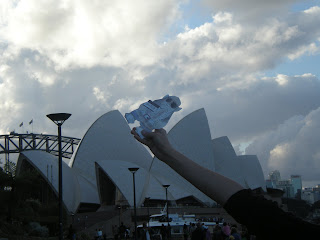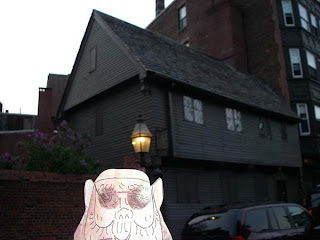
Teran on the single engine plane, Katana

Checking out the interior of Katana

Teran wanted another shot on his favorite toy

Plane of the tarmac, taxiing to the runway, then for take off

CFI Travis beginning our preflight visual inspection

More preflight inspection

Buckle in, but not as tight as a car seat belt
 Ready to roll
Ready to roll
Why, you may ask, is she blogging random pictures of a plane? Because I FLEW a plane! NO, not flew in one. I FLEW a plane! I was the PILOT who maneuvered and controlled the plane! I was the one taking off, steering, flying, and landing the plane! (albeit the flight instructor, Travis Morgan sat in the passenger seat to supervise). LOL.
Contrary to popular belief, I am not insane. What a Rush! This was the ultimate adventure! What better place to post it, than in this adventure travel site where gnomes rule. My gnome, TeranUSA, shared this flight experience with me. It was our FIRST flying experience!
The best thing about having a certified flight instructor (CFI), on a beginning flight, is that you don't have the responsibility of checking every flight detail before take off. Something I plan to learn to be a private pilot. It was exhilarating to fly, and be in charge of the control stick! The pro took charge of all the details of operating the switches and buttons and communicating with air control. I steered, took off, flew and landed. All of it accomplished rather easily, though the concept sounds intimidating.
Steering the plane was probably the most challenging of the four parts. You have to remember to steer with your feet. It sounds harder than it actually is. Basically, you only steer this way while you're on the ground. You push down with the right foot to turn right. The left foot is pushed down to turn left. Both feet push down to come to a stop. It's different, but you get the hang of it. I had to stop steering for a while so that the CFI could check the engine. He had to make sure the single engine plane wouldn't stall in mid-air. That would be bad, REALLY BAD!
Next was the take off. We had to wait for air clearance from the air control. The CFI took charge in communicating in pilot lingo. They use the alpha-beta system. You know, "alpha" for "A," “beta” for “B” and referring to the name of the plane as something like "Wolf 1-5" and other flight details.
Upon clearance, I steered the plane (using my feet, of course) onto the runway. I had to keep it centered on the runway. Oh, yes, I forgot to mention. There's basically no gas pedal in a Katana. I just had to brake and turn it off. I could make it go faster in the air, but I don't think you can on the ground.
The most important thing about taking off is the airspeed. I had to watch the dial until it got up to about 44, and then pull back slightly on the control stick. Then when it got up to around 68, I pulled back a little more. Between 44 and 68 was when we got in the air. Then I just had to even out the plane by pushing the stick shift forward and back to level the plane.
For me, one of the nicest things about the Katana is that it is roomy on the inside, but small enough to keep you from being afraid once you are in the air. Commercial planes are so big that just taking off gives you a sinking feeling in your stomach. It takes a lot more effort and runway to get a big plane up to the right elevation so that you can level it out. That is why it's initial climb ends up being really steep. With the Katana, you hardly feel like you're taking off at all. You're just there, gliding. Sure, you're up really high, but you don't feel a dramatic change. It's just a switch in scenery from ground to aerial view. I won't deny it, that would probably scare a lot of people, but not me. Visual changes don't frighten me at all, unless they're accompanied by a loud noise or sickening feeling. So I felt just as secure as if I had two feet firmly planted on the ground. Steering was a piece of cake. Just pull up to stay up, push down slightly to go down. Going left just means pushing the stick shift to the left, then bringing it slightly back up to the right to even out the plane. The opposite applies to going right.
The only part that even slightly scared me, was what took place after the instructor asked, "Do you like roller coasters?" Well, roller coasters are kinda fun, so I was like, "Sure." Then he explained about positive G's and negative G's. Easy to talk about Physics. Much different to actually experience Physics! I'll admit, it's a bit scarier than a roller coaster. Thankfully, the CFI steered this one.
Here's what happened. When he brought the plane up on the “roller coaster ride,” I started feeling really lead heavy, about twice my actual weight. So, if you weighed 300 pounds, you'd feel like you weighed 600. (No, I don't weigh 300 pounds, it's just an example!) Then, when the plane droped back down, it got a little strange. Everything started floating. The free key attached to the ignition key floated upward. The dust lifted off the floor. Two of us pilots hovered above our seats. I was too busy trying to stay IN my seat, and keeping my organs intact, to notice dust particles floating. The experience was far more surreal than a roller coaster ride. I think my liver actually started floating too! Just kidding. But that's what it felt like. It was good that the CFI warned me about the details of the expected effects. Despite my anticipation, I was still too bewildered by bodily sensations to notice how the negative G's were affecting things around me. There was a sense of helplessness. Once the bewilderment of this experiment is over, I may be ready to tackle more G forces. I may even overcome my initial disorientation.
Once I was back in steering control, I did a few sharpe turns in the air before heading back to the airport. It was a lot sooner than I would have liked. Compared to everything else, landing the plane was a cinch. When we received the control tower clearance, I knew the flight would soon be over. (*sigh*) I suppose I should give you a better description than that.
We had to follow another single engine plane that was cleared to land before us. I had to keep the plane high enough not to hit the ground, and then gradually descend. I did this by pushing down slightly with the stick shift, and pulling up a bit when necessary. I had to make sure to line up the runway and not descend too hard. I really made a great landing! By great, I mean only the instructor got his foot blown off, and I only lost half the plane. Just kidding! I made it out fine. It was a smooth landing, and we both got out safely. I mean, how hard can it be to steer a plane?
This flight opportunity is one of the finest rewards I've ever received!
The CFI commended my natural aptitude for flying and encouraged my aviation pursuit.
I am really looking forward to next Saturday's Aviation Camp. At "ground school", I'll learn basic aerodynamics, aircraft operations, instrument interpretation, taxi, takeoff, and landing procedures. It will be great! I'm also taking Ground Pilot class @ THS. After that, just two more "ground" classes and I could be on my way to getting my Private Pilot's license (PPL) by putting in the qualifying flying hours. If I show promise in aviation, I could have a "flying success" in my future!
-Tasting the flavor of places across the globe,
Teran and Pepper (aka Kasey)






























 Top 4 pictures: Danish booth; Lego Viking ship & Danish almond cookies (recipe below); TeranUSA on Denmark map&flag
Top 4 pictures: Danish booth; Lego Viking ship & Danish almond cookies (recipe below); TeranUSA on Denmark map&flag



















